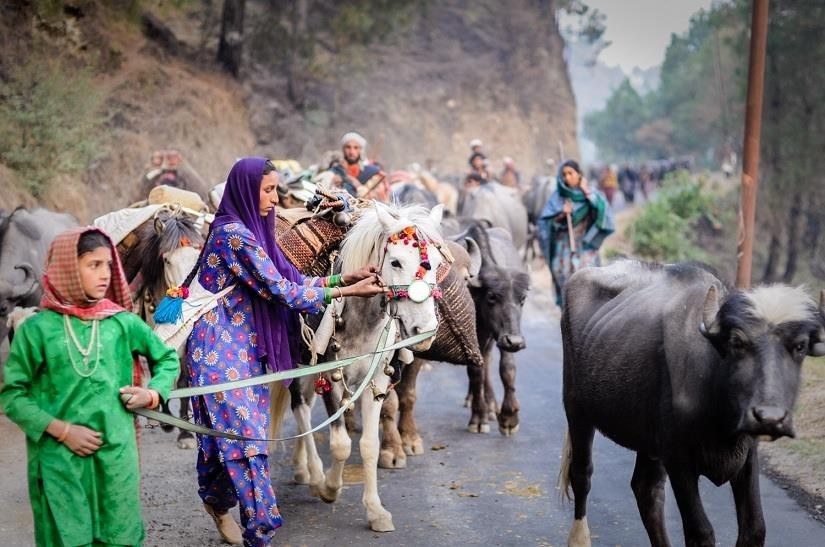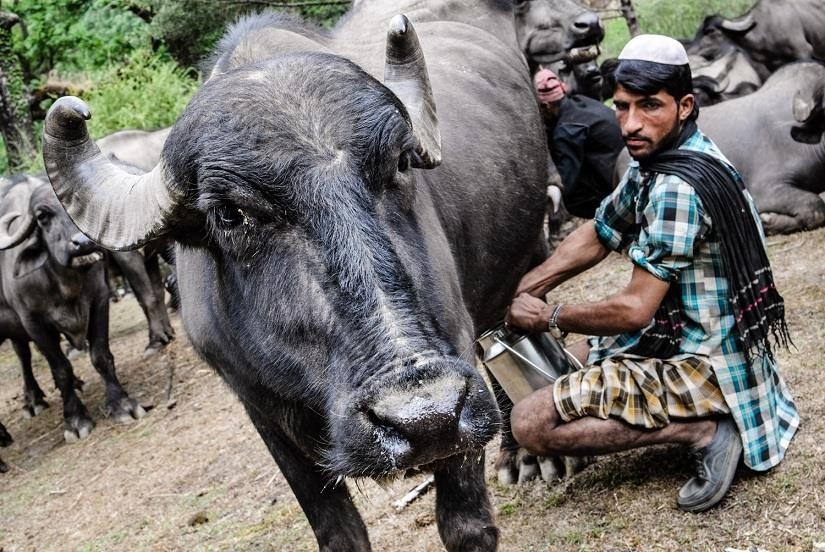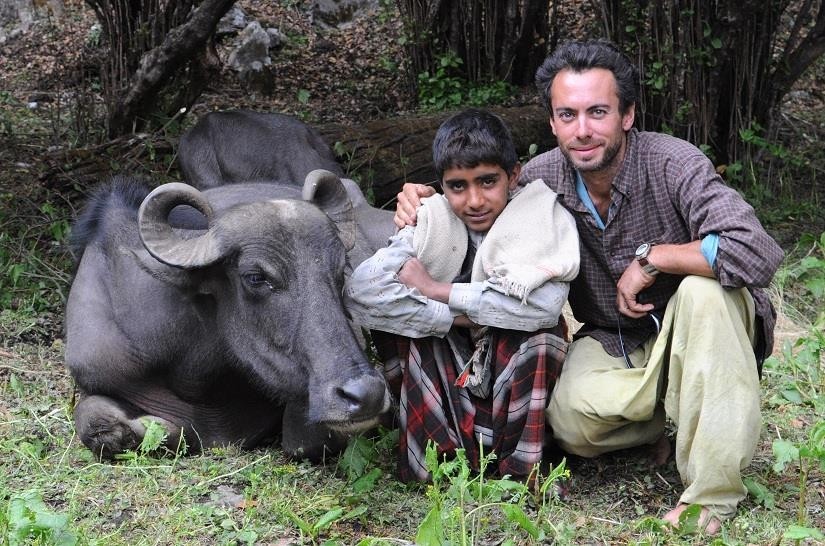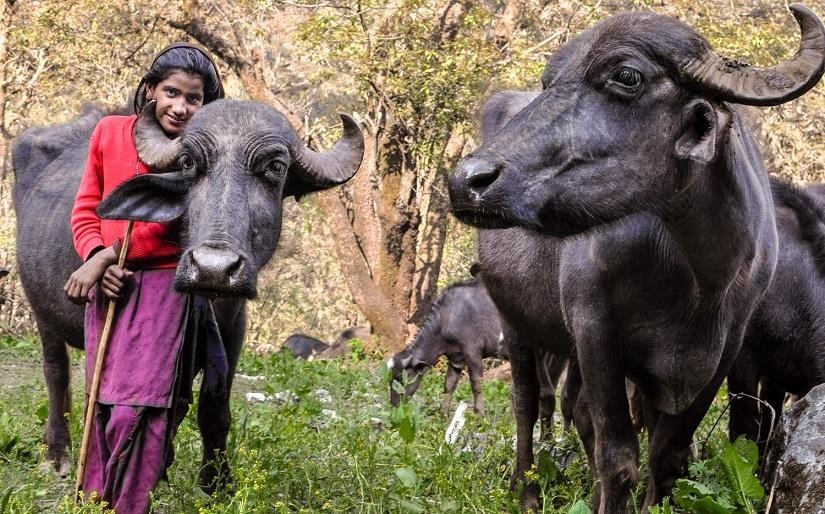Travelling with the Van Gujjars: Tracing a forest-dwelling nomadic tribe’s spring migration
- The Van Gujjars, who trace their origins back to Kashmir, first came to the Shivaliks some 1,500 years ago A community that lives off the land, an annual migration of around 200 kilometres to the middle Himalayas and an everlasting bond with buffaloes that would put a dog’s love to shame. It was enough of a draw for American photojournalist Michael Benanav to make his way to India in order to spend some time with the Van Gujjars.
- The idea was to document the lifestyle of these forest-dwelling nomads, which is under constant threat of being swallowed by the developing world. For 44 days, Benanav followed the Van Gujjars on their spring migration from the jungles at the foothills of the Shivalik Hills to the lush pastures high up in the mountains. And en route, he had a fascinating insight into their life, which he has documented in the book, ‘Himalaya Bound’.
- The Van Gujjars, who trace their origins back to Kashmir, first came to the Shivaliks some 1,500 years ago; today, they are distributed across the many northern states. Their lives essentially revolve around their buffaloes — their only real asset, given that the milk is their only source of income and is vital for their sustenance as well. As a result, their wellbeing is of prime importance to the Van Gujjars. As Benanav puts it, “Van Gujjars were like doting servants to their buffalo masters.”
- Having traveled to countries such as Egypt, Morocco, Mali, Jordan, Turkey and Mongolia in the past, Benanav bumped into nomads on various occasions and was fascinated by their lifestyle and culture.
- Khatoon adjusts the load on one of the mules during the migration. All images courtesy Michael Benanav Chamar milks one of the buffaloes. The milk is the only source of income for the Van Gujjars.
- “I think I’m particularly drawn to these communities because I really like to walk and be out in the wilderness. So the places I’ve gone to, I’ve run into nomadic people, who lead a life that I happened to be naturally attuned to. They have a great tradition of hospitality, which makes the time spent with them really enjoyable. I always wanted to migrate with one of these tribes and I couldn’t imagine a more beautiful place to do it than the Himalayas,” Benanav says on a visit to the Mussoorie Mountain Festival recently.
- Each spring, the jungles dry up down below while the snow melts high up in the mountains, revealing fresh grass that is scrumptious fodder for the buffaloes. It’s when the Van Gujjars bundle their meagre belongings and begin their long march that takes them to an altitude of over 3,000 metres. Benanav first approached the Society for the Promotion of Himalayan Indigenous Activities, who work with the Van Gujjars, and soon found himself in the jungles outside of Dehradun, just as the entourage got moving. It’s a massive undertaking that comprises men, pregnant women, children, toddlers and the elders — essentially anyone, who can make the arduous journey to their traditional grazing grounds. And of course, their beloved buffaloes.
- “Van Gujjars have never lived in a village. Typically speaking, each family will go to the same meadow in the summer and come to the same area in the Shivaliks every winter — this has been going on for generations. So even if they are nomadic, they have a deep sense of home that is attached to these places. I walked with them, herded buffaloes, ate with them, slept with them under their tents and essentially, lived their life thought those weeks,” Benanav recalls.
- “A lot of things can go wrong during this migration, but they hardly get worked up since they’ve been doing this for years. They are used to dealing with the normal risks that come with climbing a mountain,” he says.
- Quite by chance, Benanav also got a close look into what afflicts these nomads in what has been their home for centuries. Van Gujjars don’t own the land they graze and live on, so each time they were migrating, they had to get permission from the forest department, which back in the day was just a formality. But once their traditional grazing grounds, such as the one at Gangar, became a part of the Govind National Park in 1990, the Van Gujjars were told to keep out of it. It was the same case with other families down below, whose homes in the jungles were now a part of Rajaji National Park, after it was established in 1983.
- Bashi tends to the buffaloes
- “This idea of keeping indigenous, forest- dwelling people out of national parks is really just part of the way that conservation has been implemented for long. The idea is that human beings by definition are an invasive species in nature, and to protect it, they must be kept away. As a result, we have people who can be called conservation refugees affected by this green imperialism,” Benanav explains.
- The Van Gujjars, on the other hand, disagree with this idea, since they believe that they are a part of the environment there that keeps the ecosystem in balance.
- “If these areas are so special that they’ve been declared national parks, obviously they’ve done something right over all these years.
- They are attuned to the idea that they have to live in a sustainable balance with the environment, else it will not support them. So while they use the forest, they do not overuse it,” he says.
- Some of the Van Gujjar families were rehabilitated to villages such as Pathri and Gandikhatta, and these buffalo herders were now handed plots of land and asked to harvest wheat. It has had an incredible impact on their way of life. Yet, there are other families such as the one Benanav travelled with, who still attempt to follow their traditional lifestyle.
- Michael Benanav, the photographer, with 16- year-old Sharafat. Sharafat was like a younger brother to Benanav during the six weeks that the photographer lived with Sharafat’s family. This photo was taken on day 38 of the journey.
- “The more indigenous way of thinking has begun to catch on around the world. Here in India, there is the Forest Rights Act that allows tribes like the Van Gujjars to use their traditional land, even inside a national park. In this case, the forest department was just happy to ignore the law, which in turn has led to a lot of insecurity in their lives,” he says.
- Due to uncertainty over the permission that year, instead of visiting Gangar, Benanav’s friends had to make their way to another pasture at Kanasar, which was not only higher up, but also farther away. The average three weeks of migration had now extended to a six-week slog, putting the physical abilities of the family and their animals to test. Yet, even in the most trying situations, Benanav found that the Van Gujjars never broke down.
- On the toughest parts of the trail, the men would get the saddle off their pack animals and lug the load themselves. A camp away from their final destination, they were hit by a ferocious thunderstorm, where an uprooted tree landed on a few buffalo yearlings, breaking one of their legs.
- “The bone was out and there was no way it could walk the last 10 km over an incredibly steep and exposed pass. I wondered if they were going to euthanise it. What they did instead was patched up the leg, which I thought was an incredible feat of wilderness, veterinary medicine, and then physically carried the calf on a makeshift stretcher, all the way to the final destination,” he says.
- “It totally blew my mind and I realised what these animals meant to them. They did it because of their love for these animals, not for some economic gain. If there was a way, no animal would be left behind. These are the Van Gujjars and this is just what they do,” he adds.
- Carrying the wounded yearling to the bugyal
- Since that experience, Benanav has gone back to meet the family every few years and has noticed many changes in their lives. Some of them have considered the offer to settle in a village to secure their future, while oth ers still go through the administrative grind each year.
- “I think the most sensible approach is a collaborative one, where the conservationists, local communities and forest-dwelling people work together to protect a place. And that’s the only way to protect the environment, human rights and cultural traditions all at the same time. It won’t be possible in some places but it definitely should be the first answer, rather than the last,” Benanav says.
- The experience gathered over the years has resulted in Benanav starting the Traditional Cultures Project a few years ago, which documents these societies around the world before they disappear.
- “Things are changing really fast. The project was started to see what’s threatening them, as well as to understand how they are adapting to modern challenges. There’s something valuable about these ancient ways of living and it’s important to document it, even so that you can just remember that people lived this way,” he says.




